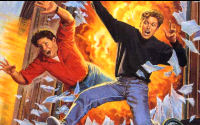

Frequently Asked Questions
1. Who is Franklin W. Dixon? Is he still alive?
If you're a young reader, I should warn you: the answer to this might be very disappointing! There is no Franklin W. Dixon, and there never was. Dixon is a pen name used by a group of writers called the Stratemeyer Syndicate, which was founded in the early 1900s by a man named Edward Stratemeyer. The Syndicate was also responsible for many other successful juvenile series, including Nancy Drew, Tom Swift, and the Bobbsey Twins.
Stratemeyer was both an imaginative author and a shrewd businessman. He would outline the basic plot of each book to be written, and one of the Syndicate writers (known as "ghosts") would write the book, being paid a flat fee and no further royalties. Stratemeyer insisted that the ghosts remain anonymous.
The first ghostwriter of the Hardy Boys books was the late Leslie McFarlane, a Canadian journalist who wrote around 15 of the original books. Since McFarlane established the characteristic style of the series, he has the strongest claim to being the "real" Franklin W. Dixon. But, of course, there have been many other Hardy Boys ghostwriters over the years.
2. I have two copies of the same Hardy Boys book -- at least, the title is the same, but actually, the books tell two completely different stories! What's up?
The answer to this lies in a giant project undertaken by Harriet Adams, Edward Stratemeyer's daughter, between 1959 and 1973. Adams felt that the Hardy Boys books, which had then been in print for over 30 years, were getting outdated, so she decided to systematically revise the first 38 books in the series.
Some of the revised stories were simply touched-up versions of the original, but others were completely new stories that weren't related to their predecessor in any way. Since there are still lots of the original books floating around, there are now several pairs of completely different Hardy Boys stories that share the same title.
3. Did Iola really die? What should we believe -- the Casefiles or the digests?
Indeed, the Hardy Boys fan does face a dilemma. The Casefiles tell us that Iola Morton was killed by a car bomb, but in the digests, Iola is alive and well. What's the truth? Well, there is more than one way to rationalize this:
- The events of the Casefiles take place at a later time. Frank and Joe are undeniably more mature in the Casefiles. Witness the evidence: they carry guns, investigate murders, and deal with international crime more than ever before. So, we can argue that within the Hardy Boys universe, the stories told in the Casefiles series all occur after those of the digests. Never mind the publishing dates -- in time, the Casefiles occur after the digests. (By this reasoning, it would seem that Iola really is dead. She's still alive in the digests because the events in the Casefiles haven't yet happened -- but they will.)
- The Casfiles and digests take place in different universes. Alternatively, we can conceive of the Casefiles and the digests as two separate continuities -- two different fictional worlds that do not need to be consistent with each other. Events in one continuity would therefore have no bearing on the other. Casefiles Iola is dead, and will remain dead, while Digests Iola is alive, and will remain alive.
- The Casefiles series is not canonical. From a historical perspective, the Casefiles series was only a tiny blip on the radar, while the digests are direct descendants of the original Hardy Boys books released in 1927. A traditionalist could therefore argue that the digests are the highest authority in today's Hardy Boys universe, due to their pedigree and longevity. On this view, the Casefiles could be considered apocryphal -- i.e. they didn't "really" happen; they were just a short-lived and ill-fated experiment that has no bearing on the "real" Hardy Boys continuity.
4. I've noticed that Grosset & Dunlap has used several different cover formats for the Hardy Boys books they published. Has anyone tried to classify these formats?
Well, I have. I've always been keenly interested in the graphic design of the books. If you're interested, too, go to the cover design page.
5. On the inside front and back covers of a lot of the Grosset & Dunlap books, there are a bunch of small scenes. Where did each scene come from?
The inside front and back covers are known as "endsheets" or "endpapers." On the multi-scene endsheets, which were used during the 1960s and 1970s, all of the small scenes do indeed come from Hardy Boys covers. For identification of the individual scenes, go to the endsheets page.
If you have a question that I haven't answered, don't hesitate to ask! Email me at woxford at mun dot ca.
